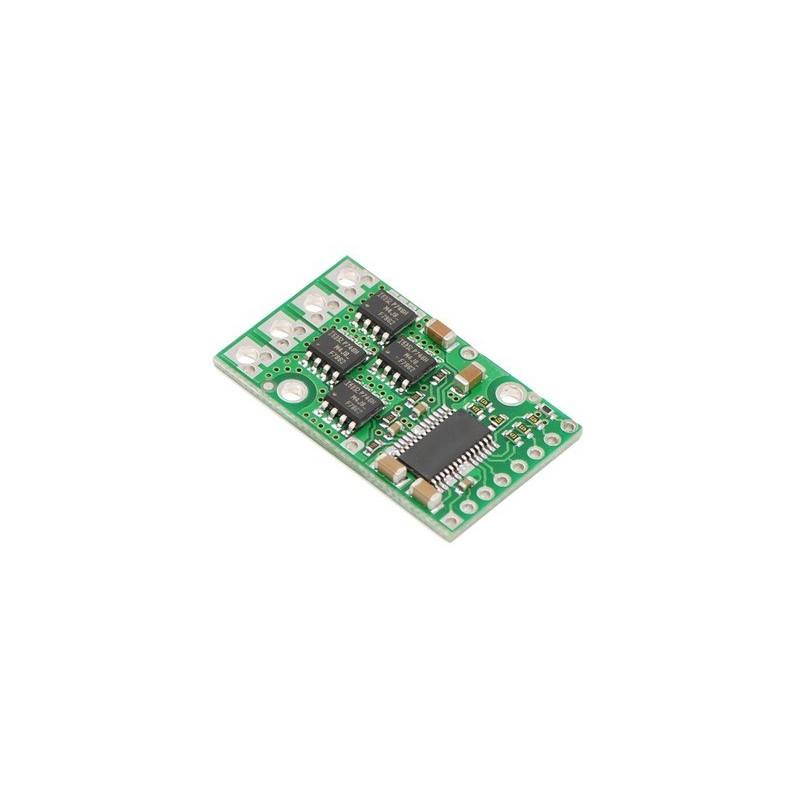



145,93 zł Netto
Wysokoprądowy sterownik silnika DC 24v12 umożliwia sterowanie silnikiem DC w systemach do 40 V przy zachowaniu kompaktowych wymiarów i prostego interfejsu PWM/DIR. Moduł sprawdza się w napędach robotów i urządzeń mobilnych wymagających prądu do 12 A bez radiatora, przy możliwości zwiększenia wydajności prądowej przez dodatkowe chłodzenie i odpowiednie filtrowanie zasilania. Pololu 757
Pololu High-Power Motor Driver 24v12 przeznaczony do dwukierunkowego sterowania jednym szczotkowym silnikiem prądu stałego o podwyższonej mocy. Moduł wykorzystuje dyskretny mostek H oparty na tranzystorach MOSFET typu N i obsługuje napięcie zasilania w zakresie 5,5–40 V. Kompaktowa płytka o wymiarach 1,3 × 0,8 cala umożliwia dostarczanie do 12 A prądu ciągłego bez radiatora, a przy dodatkowym chłodzeniu do około 17 A.
Sterownik oferuje prosty interfejs sterowania wymagający dwóch linii sygnałowych, co ułatwia integrację z mikrokontrolerami i sterownikami nadrzędnymi. Obsługa trybów sign-magnitude oraz locked-antiphase umożliwia dobór sposobu regulacji prędkości i kierunku do wymagań aplikacji. Zintegrowana detekcja wybranych zwarć oraz sygnalizacja stanów awaryjnych na wyjściach FF1 i FF2 zwiększają odporność na typowe błędy okablowania.
Układ nie posiada sprzętowej ochrony przed odwrotną polaryzacją ani zabezpieczeń nadprądowych i temperaturowych, dlatego w aplikacjach pracujących blisko granic parametrów zalecane jest stosowanie odpowiednio dobranej pojemności filtrującej przy zasilaniu, zapewnienie chłodzenia oraz monitorowanie prądu z wykorzystaniem zewnętrznego czujnika.
Cechy
Producent BTC Korporacja sp. z o. o. Lwowska 5 05-120 Legionowo Polska sprzedaz@kamami.pl 22 767 36 20
Osoba odpowiedzialna BTC Korporacja sp. z o. o. Lwowska 5 05-120 Legionowo Polska sprzedaz@kamami.pl 22 767 36 20
Dual MAX14870 Motor Driver to podwójny sterownik silników DC kompatybilny z Raspberry Pi pozwalający na wysterowanie dwóch silników DC napięciem 4,5-36V prądem ciągłym 1,7A. Pololu 3759
Nakładka do STM32 Nucleo ze sterownikiem niskonapięciowego, trójfazowego silnika BLDC. Shield oparty jest na układzie STSPIN233. Świetnie nadaje się do sterowania silnikami w aplikacjach mobilnych, takich jak roboty, zabawki oraz drukarki termiczne. Nakładka wyposażona jest w złącze zgodne ze standardem Arduino UNO R3. X-NUCLEO-IHM17M1
Moduł ze sterownikiem silnika krokowego oparty na układzie DRV8434A. Pozwala na zasilanie silnika bipolarnego prądem do 1,2 A na fazę i napięciem od 4,5 V do 45 V. Komunikacja przez interfejs SPI. Pololu 3768
Brak towaru
Moduł 4-kanałowego sterownika silników DC z mikrokontrolerem RP2040. Pozwala na podłączenie enkoderów i jest wyposażony w złącze QW/ST. Pimoroni PIM636
Sterownik silnika krokowego A4988 operujący na napięciach 8..35 V i prądzie 1,2 A. Pololu 2128
Wysokoprądowy sterownik silnika DC z pomiarem prądu 36v20 CS Pololu umożliwia sterowanie silnikami DC o wysokim napięciu i dużym poborze prądu z jednoczesnym pomiarem obciążenia. Moduł sprawdza się w zaawansowanych projektach robotycznych i napędowych, gdzie wymagane są wysoka wydajność prądowa, elastyczne tryby sterowania oraz możliwość precyzyjnej kontroli prądu silnika.
Dwukanałowy sterownik silników DC oparty na ukłądzie HR9933. Pozwala na kontrolowanie ruchu napędów o napięciu zasilania do 10 V i poborzę prądu do 1,5 A. DFRobot DRI0040
Moduł zawiera dwa sterowniki silników L293D oraz rejestr przesuwny 74HC595. Rejestr przesuwny rozszerza 3 linie Arduino do 8 linii, co pozwala na sterowanie kierunkiem pracy silników. Wyjście L293D jest bezpośrednio sterowane wyjściami PWM Arduino
Pololu G2 18v17 to miniaturowy sterownik silnika DC. Zasilanie sterownika: 6,5 - 30 V. Wydajność prądowa modułu: 17 A.
Moduł posiada zabezpieczenie przed napięciem wstecznym i przepięciami. Pololu 2991
Brak towaru
Sterownik silnika krokowego oparty na układzie TB67S249FTG. Pozwala sterować silnikiem krokowym napięciem od 10 do 47V, z maksymalnym natężeniem prądu do 1,8A. Sterownikiem można sterować przy pomocy: USB, Serial TTL, I2C, RC (PWM modelarski), wejście analogowe czy enkoder kwadraturowy. Pololu 3138
Sterownik silników DC, który pozwala na kontrolowanie ruchu dwóch napędów za pomocą interfejsu I2C. Płytka z przylutowanymi złączami. Pololu 5051
Brak towaru
Sterownik silnika krokowego z układem MP6500, pozwala na zasilanie silnika bipolarnego prądem do 2A na fazę, bez użycia radiatora. Układ może być zasilany napięciem w zakresie 4,5...35V. Pololu 2969
Dwukanałowy sterownik silników prądu stałego (DC) o napięciu pracy od 6 do 30 V i maksymalnym prądzie ciągłym do 20 A. Może być sterowany sygnałem PWM lub za pomocą wbudowanych przycisków. Cytron MDD20A
Kompaktowy sterownik silnika krokowego z układem TMC2226 o napięciu pracy od 4,75 do 29 V. Oferuje płynną, cichą pracę, wysoką wydajność, różnorodne tryby pracy oraz łatwą konfigurację. Jest sterowany przez interfejs STEP/DIR i stanowi idealne rozwiązanie dla drukarek 3D oraz podobnych zastosowań. BIGTREETECH TMC2226 V1.0
Pololu Dual G2 High-Power Motor Driver 24v14 to rozszerzenie pozwalające na sterowanie dwoma silnikami prądu stałego przeznaczone dla Raspberry Pi. Silniki mogą być zasilane napięciem 6,5-36V i pobierać maksymalnie prąd o natężeniu do 14A. Pololu 3752
Wydajny sterownik przeznaczony do obsługi jednego silnika szczotkowego DC z enkoderem w systemie Pimoroni Yukon. Oferuje prąd ciągły do 8 A oraz szczytowy do 12 A przy napięciu zasilania od 5 do 17 V, co czyni go odpowiednim do wymagających projektów robotycznych. Moduł zapewnia precyzyjną kontrolę dzięki obsłudze enkodera oraz wbudowanym czujnikom prądu, temperatury i błędów. Pimoroni PIM691
Brak towaru

Wysokoprądowy sterownik silnika DC 24v12 umożliwia sterowanie silnikiem DC w systemach do 40 V przy zachowaniu kompaktowych wymiarów i prostego interfejsu PWM/DIR. Moduł sprawdza się w napędach robotów i urządzeń mobilnych wymagających prądu do 12 A bez radiatora, przy możliwości zwiększenia wydajności prądowej przez dodatkowe chłodzenie i odpowiednie filtrowanie zasilania. Pololu 757
